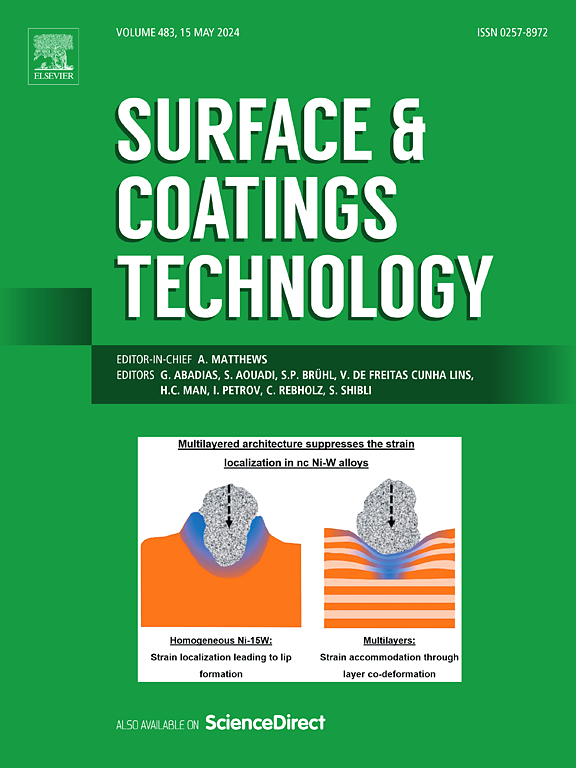Engineering magnesium alloys with robust discrete superhydrophobicity for corrosion mitigation
IF 5.3
2区 材料科学
Q1 MATERIALS SCIENCE, COATINGS & FILMS
引用次数: 0
Abstract
This study demonstrates the fabrication of stable SnO₂ layers on AZ31B magnesium alloy using SnCl₂ as a precursor through solution immersion and oxygen-assisted thermal treatment. Subsequent stearic acid modification conferred superhydrophobicity as well as exceptional mechanochemical/long-term durability to the coatings. Tafel polarization tests demonstrated that the superhydrophobic surface displayed exceptional corrosion resistant property. Specifically, the superhydrophobic surface reduced corrosion current density to 0.794 % of that observed on the bare magnesium alloy (1.259 × 10−6 A cm−2 vs. 1.585 × 10−4 A cm−2). Additionally, an interfacial model for corrosion resistance mechanism was developed to illuminate the intricate synergistic effect by which air-trapped superhydrophobicity and the inherent chemical stability of SnO₂ collaborate to impede electrochemical degradation processes in an environment with chloride ions present.
具有稳健离散超疏水性的工程镁合金缓蚀剂
本研究以SnCl 2为前驱体,通过溶液浸泡和氧辅助热处理,在AZ31B镁合金表面制备了稳定的sno2层。随后的硬脂酸改性赋予涂层超疏水性以及卓越的机械化学/长期耐久性。Tafel极化试验表明,超疏水表面具有优异的耐腐蚀性能。具体来说,超疏水表面将腐蚀电流密度降低到裸露镁合金的0.794 % (1.259 × 10−6 A cm−2 vs 1.585 × 10−4 A cm−2)。此外,还建立了一个耐腐蚀机理的界面模型,以阐明在氯离子存在的环境中,空气截留的超疏水性和SnO 2固有的化学稳定性共同阻碍电化学降解过程的复杂协同效应。
本文章由计算机程序翻译,如有差异,请以英文原文为准。
求助全文
约1分钟内获得全文
求助全文
来源期刊

Surface & Coatings Technology
工程技术-材料科学:膜
CiteScore
10.00
自引率
11.10%
发文量
921
审稿时长
19 days
期刊介绍:
Surface and Coatings Technology is an international archival journal publishing scientific papers on significant developments in surface and interface engineering to modify and improve the surface properties of materials for protection in demanding contact conditions or aggressive environments, or for enhanced functional performance. Contributions range from original scientific articles concerned with fundamental and applied aspects of research or direct applications of metallic, inorganic, organic and composite coatings, to invited reviews of current technology in specific areas. Papers submitted to this journal are expected to be in line with the following aspects in processes, and properties/performance:
A. Processes: Physical and chemical vapour deposition techniques, thermal and plasma spraying, surface modification by directed energy techniques such as ion, electron and laser beams, thermo-chemical treatment, wet chemical and electrochemical processes such as plating, sol-gel coating, anodization, plasma electrolytic oxidation, etc., but excluding painting.
B. Properties/performance: friction performance, wear resistance (e.g., abrasion, erosion, fretting, etc), corrosion and oxidation resistance, thermal protection, diffusion resistance, hydrophilicity/hydrophobicity, and properties relevant to smart materials behaviour and enhanced multifunctional performance for environmental, energy and medical applications, but excluding device aspects.
 求助内容:
求助内容: 应助结果提醒方式:
应助结果提醒方式:


